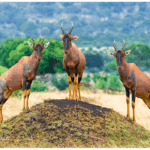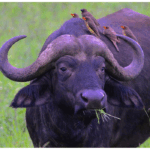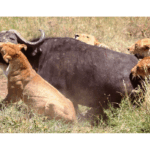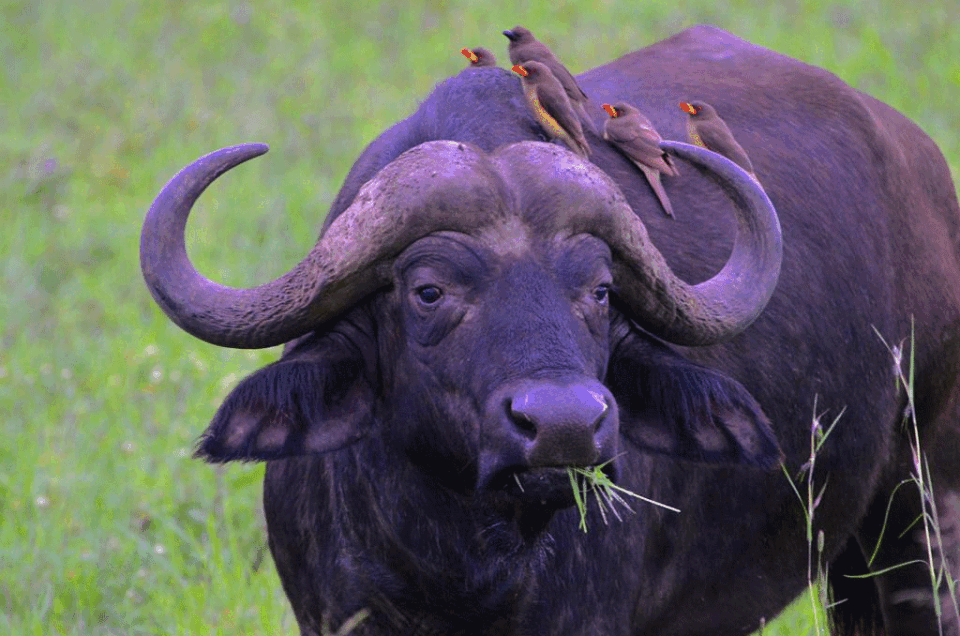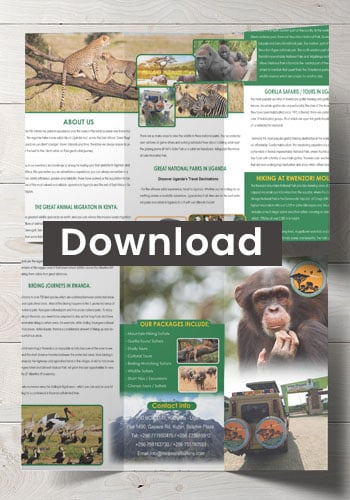The Uganda Buffalo/Cape Buffalo they live in two types of groups -family herds. These contain mainly females, calves and bachelor herds. These Buffaloes are found in most of Uganda’s national parks. More so, they stay in open grasslands but they also prefer swampy areas more especially during hot temperatures.
African buffalo / cape buffaloes are one of Africa’s ‘big five’ safari animals along with leopards, rhinoceroses, elephants, and lions. They’re considered dangerous to hunt and can reach speeds of up to 60 kilometers per hour (37 miles per hour). Found in sub-Saharan Africa, African buffalo thrive in various grassland habitats from semi-arid bush lands to coastal savannahs and even low-altitude rainforests. They need to live close to a water source during day and they spend the all night grazing /feeding.
There are four subspecies of African buffalo, including the more common Cape buffalo, the forest buffalo, the West African savannah buffalo, and the Central African savannah buffalo. They spend most of their time in herds of anywhere between 15 to 1750 buffalo, with an average of 380. Buffalo calves are born throughout the year.
All types of buffalo are herbivores, feeding primarily on grasses and other kinds of plants. Like cows, buffalo chew their cud—partly digested food—to increase their intake of nutrients. These herbivores can fall prey to various predators depending on their habitats and regions, including humans, lions, leopards, hyenas, and wild dogs. However, buffalo can be vicious and strike out to defend themselves.
Cape buffalos are extremely social and live in large mixed herds up to 1400 members!!! Both sexes have a separate hierarchy, with males dominant over females. Members of the same subgroup will stay in direct contact with each other and will often sleep with their heads resting on one another.
There are two types of buffaloes in Uganda and these include the small forest buffaloes which are very common in Semuliki national park and then those huge savannah buffaloes like those found in Murchison falls, Kidepo valley, Lake Mburo and Queen Elizabeth national parks.
Without fresh green feed, buffaloes deteriorate rapidly. They devote a large portion of their time to grazing and feeding. After grazing on grass, just like cows, they spend time chewing their cud (or bolus) to extract even more nutrients from their food.
Through their grazing behaviors, buffalo maintain the grasslands within their habitat. They help to prevent single species of grass from dominating ecosystems, therefore maintaining a healthy level of biodiversity. As they migrate, they then disperse seeds from the vegetation they have eaten, aiding in plant regeneration and the spreading of seeds.
The special feature of buffaloes, Broad hooves, well-developed false hooves, and lack of an inter digital cleft are advantageous on wet ground. Capable of running at speeds up to 53-60 km/hour, enough to outrun lions, but not adapted to running far. Skin may be >1 cm thick. Females have two pairs of inguinal mammas.
The grassland is one of the most successful of Africa’s wild ruminants; the Cape buffalo thrives in virtually all types of grassland habitat in sub-Saharan Africa, from dry savanna to swamp and from lowland floodplains to Montana mixed forest and glades, as long as it is within commuting distance for water up to 20 km.
African buffalo have birthing seasons reported to coincide with the wet season in multiple sites and a gestation period with a mean of around 340 days, a female has her first calf at age four to five years and she usually gives birth only every two years
.In wild buffaloes have an average lifespan of 15 to 25 years while domestic buffaloes can live as long as to 40 years.
